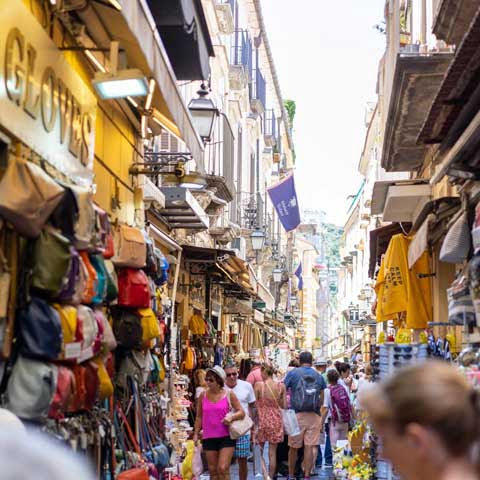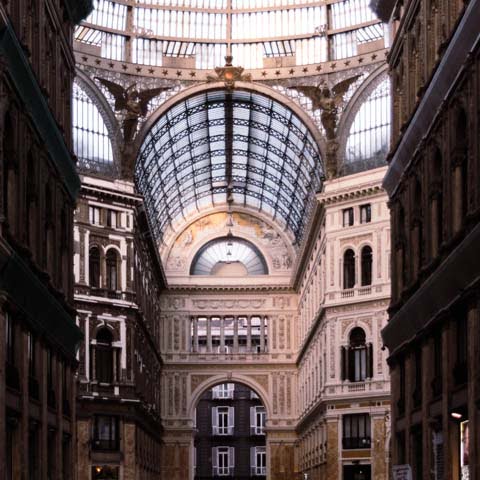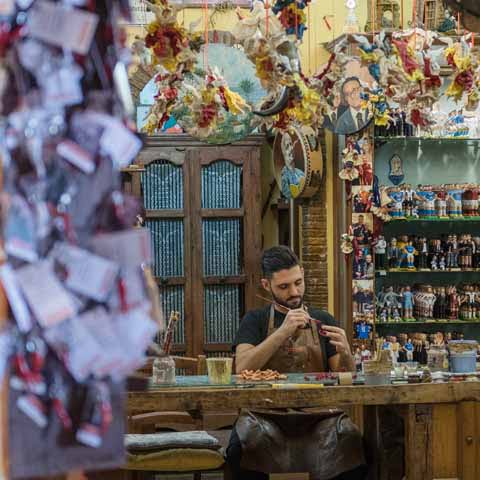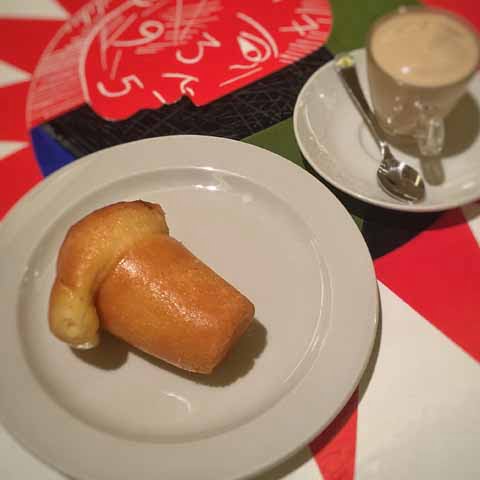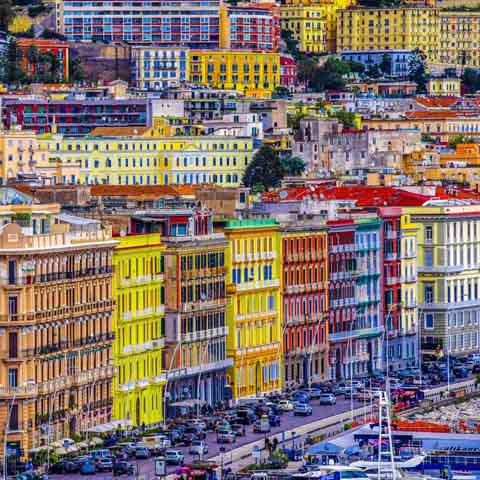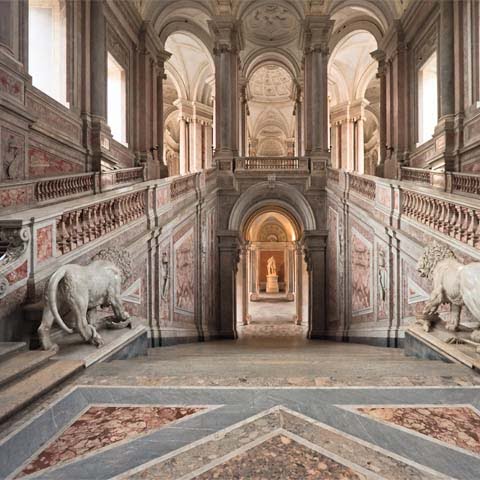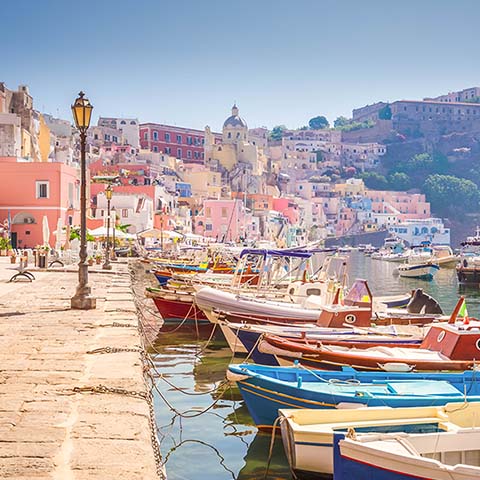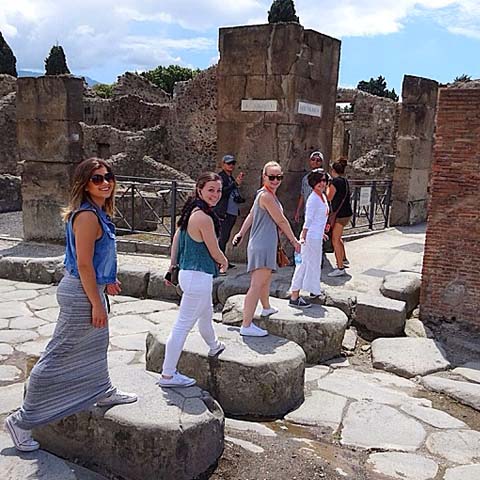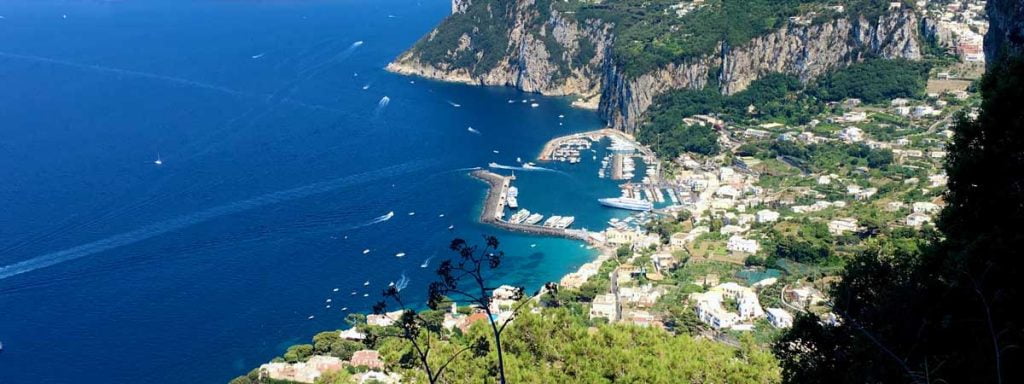Naples is one of the largest cities on the southwestern coast of Italy and has an abundance of lively and adventuresome activities for its visitors. The city is the third largest municipality in Italy and offers stunning views of the Gulf of Naples and the Tyrrhenian Sea. The best way to take in the city is to slow your pace and revel in the beauty and adventures one by one.
FESTIVAL & EVENTS IN NAPLES
With a long and varied history, Naples is home to a variety of fascinating cultural traditions.
Perhaps the most celebrated and best-known Naples event is the Festival of San Gennaro. The event takes place annually on September 19 and celebrates the city’s patron saint. This festival began in the late fourteenth century when the blood of San Gennaro, kept by a bishop of that era, returned to a liquid state on the anniversary of the saint’s martyrdom. Tradition dictates that if the saint’s blood returns to liquid, the year will bring good fortune. Scientists have tried to solve the mystery of the liquefied blood but have not been able to do so. Traditionally, there are three days of the year in which San Gennaro’s blood is expected to liquify: September 19, December 16, and the first Saturday of May. Of these dates, September 19, the saint’s Feast Day, is the most important to locals and features the biggest celebrations. In fact, the festival usually begins on September 16, lasts for three days and is celebrated throughout the city.
On January 17, the city of Naples and other parts of Campania celebrate the Feast of Sant’Antuono. Historically, the people would build large cippi, or bonfires, to represent the power of Saint Anthony the Great against forces of evil. Locals would also throw wooden objects onto the fire to get rid of old items. The children often went door to door to collect firewood for the event, and the different neighborhoods of the city competed to see which one could build the largest bonfire. With time and urbanization, the fires became a hazard and are far less prevalent in modern times, though a few neighborhoods, such as Forcella, keep the tradition alive.
The Feast of the Epiphany in early January is celebrated by Neapolitans as well as the rest of Italy. This holiday has origins in an interesting legend that says three Magi Kings were on their way to take presents to baby Jesus when they became temporarily lost and had to stop for directions. They asked an old woman for directions to Bethlehem and offered for her to go with them. She initially declined but later set out with a basket of sweets of her own for baby Jesus. According to the legend, she never caught up with the Magi Kings, so she stopped at every house giving a sweet treat to the children in hopes that one of them was baby Jesus. Modern day tradition dictates that on the eve of Epiphany (January 5), children put out their stockings and the old woman known as La Befana, comes by and gives them sweets, candies, and toys if they are good, and coal if they are naughty. If you are visiting during this holiday, be sure to visit Plebiscito Square on the eve of Epiphany for child-friendly activities in anticipation of the event.
In general, the Easter season brings celebrations across Italy. However, Naples’ traditions are a bit unique. On Good Friday on the Island of Procida, church leaders leave at dawn from the top of Terra Murata and travel through the city streets in a long procession that includes “mysteries” or floats representing scenes from the Bible. The procession ends at Marina Grande and is very well attended.
On Easter Monday, also known as Pasquetta in Italy, Neapolitans commemorate the scene described in the Bible in Luke 24:13-15 where the risen Christ meets with his disciples on the road to Emmaus the Monday after the resurrection. Still today, it is somewhat customary for young people to plan a purposeful outing on this day.
In July, locals celebrate the miraculous Madonna of the Church of Santa Maria del Carmine. At the center of the celebrations is the church’s thirteenth century icon of Madonna della Bruna, which is said to have been brought to Naples by the original Carmelites. The main feature of the event is an impressive fireworks display that is enjoyed by locals and pilgrims alike.
Maggio dei Monumenti is a unique cultural celebration in Naples’s historic city center that lasts one month. Each May, the city organizes a series of events, such as guided tours, concerts, theater performances, exhibitions, and more to highlight the cultural heritage of Naples.
Dating back to 1997, the Napoli Film Festival honors the year’s best independent films, with a particular focus on filmmakers from Naples and the Campania region. As a week-long event that usually occurs at the end of September and beginning of October, the festival regularly features distinguished guests and members of the international film industry. This celebration of film also features workshops and other events that promote cinema in the Campania region.
Each September, locals come together to celebrate the Festa di Piedigrotta folk festival. A musical event held in honor of the Madonna of Piedigrotta, this festival consists of concerts, religious events, and music workshops. Interestingly, the popular nineteenth century Neapolitan song Funiculì, Funiculà, which commemorated Mount Vesuvius’s first funicular railway, debuted at the Festa di Piedigrotta.
OUTDOOR
One of the areas of Naples most alive with history is the Quartieri Spagnoli. This area is actually a grid of approximately eighteen by twelve city streets in which a population of roughly fourteen thousand people of the working class reside. The area originally came to life in the sixteenth century to house Spanish garrisons, but nowadays it is full of different sized and colored buildings with very narrow streets that are constantly filled with people. Take time to wander through this exciting district and visit its many historic churches, enjoy the sights and sounds, and shop wares such as Capodimonte porcelain, small paintings, and cameos.
Each year, especially during the Christmas season, travelers look forward to visiting Via San Gregorio Armeno. This busy street is called Nativity Scene Road because of the many sculptors, gilders, and silversmiths that create beautiful and unique figurines for nativity scenes, a tradition that was invented in Naples during the Middle Ages. It is worth noting that the street and its shops are generally less busy outside of the Christmas and Advent season and allow for a more leisurely adventure. No matter the time of year, a stop at Via San Gregorio Armeno is a must for all travelers visiting Naples.
The lovely Piazza del Plebiscito is a breathtaking, large square in Naples that is in the shape of an amphitheater. The square is one of the more recently renovated and popular squares of the city that is sometimes home to open-air concerts of musicians such as Elton John, Bruce Springsteen, and Maroon 5. Not to be missed during your visit here is the grand and majestic Church of San Francesco di Paola which dominates the piazza with its impressive colonnade.
Piazza Bellini is another Naples city square that serves as a meeting place for locals and visitors. This square can be traced back to at least the seventeenth century and is still home to striking palaces and buildings. While visiting here, do not miss the statue of famous composer Vincenzo Bellini, known for his work with the Music Conservatory of San Pietro a Majella. In the square, visitors can also admire the subterranean ruins of the original city of Neapolis’s walls, which are partially uncovered.
Piazza Gesù Nuovo is both the name of a church and a square in Naples that is a great spot to enjoy the city’s nightlife. The square is best known for three major sightseeing locales including the Basilica of Santa Chiara, the Church of Gesù Nuovo, and the spire of the Immaculate Virgin, which dates back to the mid-eighteenth century.
The Basilica of Santa Chiara is part of one of the most important religious complexes in Naples featuring the church, a monastery, an archeological museum, and tombs. After admiring the Romanesque, Gothic, and Baroque elements of the church, be sure to stop by the Cloister of the Poor Clares, a verdant respite in the city center of Naples that features colorful majolica tile decorations.
The Church of Gesù Nuovo, with its unique façade featuring diamond-shaped stones, has origins in the fifteenth century, but it was subsequently renovated in the sixteenth century. Travelers should not miss the beautiful Baroque interior or the final resting place of local Saint Giuseppe Moscati, a nineteenth and twentieth century doctor. Another interesting aspect of the church is the — literal — bombshell on display. During World War II, a bomb was dropped on the church, but it miraculously failed to explode and today it is housed inside of the church.
One of the city’s ancient sites is the Roman Theater, which dates back to the first century BC. The Roman Emperor Nero is said to have performed his operas here. According to legend, during one of Nero’s performances, an earthquake struck Naples. Unfazed by the shaking ground, Nero continued to sing and once finished, he gave thanks to the members of the audience, as well as the gods, for applauding.
INDOOR
One of the more interesting and educational indoor activities in Naples is to visit the Museo Archeologico Nazionale di Napoli or National Archaeological Museum of Naples, which is among the oldest archeological museums in the world. The museum has the best collections of Greek and Roman artifacts in Italy including items from the ruins of Pompeii, a famous mosaic of Alexander the Great, beautiful marble sculptures, ancient coins, silverware, and even jewelry. This museum is an absolute must-see.
The Capodimonte Museum and Gallery can be found in the Palace of Capodimonte. The museum opened in the mid-twentieth century and includes paintings and sculptures. It is one of the largest museums in Italy and is known for its collection of works that includes art by Botticelli, El Greco, Raphael, Titian, and Michelangelo. Offering an incredible view of the city, the palace was once the site of the Capodimonte porcelain factory.
The San Martino Museum is located in the former Carthusian Monastery of San Martino. It stands next to Castel Sant’Elmo and together they are the most visible landmarks in the city as they are perched high on the Vomero Hill. The ornate museum is dedicated to Neapolitan history and culture. Be sure not to miss the exhibit on historical nativity scenes and the large Cuciniello nativity scene, an excellent example of Naples’s elaborate nativity scene tradition.
To truly understand the remarkable culture of Naples, travelers must visit the majestic Cathedral of Santa Maria Assunta. Dating back to the thirteenth century, this stunning church is composed of Gothic, Renaissance, Baroque, and Neo-Gothic elements. Though it is filled with many treasures, the true masterpiece is the Royal Chapel of the Treasure of San Gennaro, with its sublime dome, stunning paintings, and San Gennaro reliquary.
The Royal Palace Museum, located in the seventeenth century Palazzo Reale or Royal Palace, is home to collections from the Bourbon dynasty such as sculptures, porcelain, and paintings. The Royal Palace and Gardens served as a residence for the House of Bourbon for more than two centuries and boast some of the most beautiful grounds in all of Naples, with gorgeous tree-lined paths and secret gardens.
While visiting the Royal Palace, be sure to stop by the famous Teatro San Carlo, which is connected to the palace. As one of Italy’s most important opera theaters, the eighteenth-century Teatro San Carlo is actually the world’s oldest continuously active opera house. If you are visiting Naples during the first half of the year, consider attending an opera (the season typically runs from January to May) or a ballet performance (April to June).
The Church of Pio Monte della Misericordia, with its unassuming façade, actually houses one of Naples’s most important artistic treasures. It is inside this church that visitors can admire the masterpiece The Seven Works of Mercy, which was painted by Caravaggio during his period in Naples following the murder of Ranuccio Tommasoni.
For an unforgettable experience, head to the Cappella Sansevero, or the Sansevero Chapel. Home to some of the city’s most beautiful Baroque sculptures, the true masterpiece here is the Cristo Velato (Veiled Christ) by Giuseppe Sanmartino. This remarkable sculpture of Christ laying under a veil will captivate travelers of all ages. Made completely out of marble, the level of detail in the veil and Christ’s facial features make the sculpture almost appear real.
FAMILY
The Vomero district is considered to be one of the more peaceful and relaxing parts of Naples and is inhabited by the middle class and wealthy. The area comes to life each day with various museums, shops, sightseeing destinations, and cafés opening for business. Locals in the area recommend taking the Montesanto funicular railway to Vomero for stunning views of Castel Sant’Elmo and Certosa di San Martino.
Every family vacation demands a few sentimental souvenirs. Naples offers some of the best shopping in Italy amongst its hundreds of small artisan shops that offer one of a kind handmade gifts and souvenirs. Some of the offerings here include ceramics, jewelry, silver, and in some places such as Via Chiaia and Via Toledo, one can find high quality fashion boutiques.
For one of the most scenic shopping experiences in the city, stop by Galleria Umberto I. Inspired by the world-famous Galleria Vittorio Emanuele II in Milan, this late-nineteenth century shopping gallery features a stunning glass dome, beautiful mosaics, and gorgeous murals. Admire the remarkable beauty as you visit the gallery’s shops, cafés, and restaurants.
KIDS
Many children fall in love with the castles, heroes, and princesses of childhood fairytales at one point or another. Rekindle their love for those stories with visits to several of Naples’ finest castles.
Perhaps the most fairytale-like castle is that of Castel Nuovo, called Maschio Angioino by the locals. The majestic thirteenth century castle is one of the oldest in the city and offers gorgeous views of the blue waters of the Tyrrhenian Sea. When visiting this castle, be sure to take the kids to the Palatine Chapel and the civic museum, which features historic paintings from the seventeenth to the twentieth centuries.
Castel dell’Ovo is another popular seaside castle of Naples. Located on the former Megaride Island, the rectangular castle is connected to the mainland by a three-hundred-foot causeway that can make for a fabulous photography spot. Originally built by the Normans during the twelfth century, Castel dell’Ovo is officially Naples’s oldest castle. The peculiar name, which translates to Castle of the Egg, refers to a legend that states the Roman poet Virgil placed an egg in the foundations of the castle. If the egg were to break, it is said that the city of Naples would be destroyed. The castle’s unique position means that travelers can enjoy amazing sights from its ramparts. Periodically, Castel dell’Ovo also hosts art exhibitions as well as special events.
Last, but certainly not least, is Castel Sant’Elmo. Of all the castles in Naples, this one might be the most stunning, in large part because of its rare six-point star shape. The castle is located in one of the highest parts of the city on Vomero Hill, which affords beautiful views of the city and the Tyrrhenian Sea. In addition to the stunning views, today the castle is also home to the Museo del Novecento, a museum that displays twentieth century art.
UNIQUE EXPERIENCES IN NAPLES
One distinctive aspect of Naples is that its city streets still follow the grid plan of the original Greek and Roman city. This is best exemplified by the three decumani, main streets that run east to west across the city. Among these is the Decumano Maggiore, a street that is also known as Via dei Tribunali. This is one of the city’s most famous and characteristic streets featuring churches, historic buildings, artisan workshops, pizzerie, and other authentic restaurants.
Travelers can experience the same nostalgic atmosphere while walking along the Decumano Inferiore, also called “Spaccanapoli,” a term that actually translates to “split Naples.” The street is aptly named as when it is viewed from above, it clearly splits the city into two main parts. Truly, one of the best ways to explore Naples and engage with the local culture is to start with a nice, long walk along Spaccanapoli.
Underneath the city lies what many refer to as Subterranean Naples. The area is an underground network of deep and large caves created from mining over the centuries. Many visitors enjoy touring the complex layout of dark and narrow tunnels. In some places, guides will provide tourists with candles to light the way of some of the darkest tunnels. While exploring the tunnels, travelers will have the chance to admire some of the city’s oldest Greek and Roman ruins.
Naples is a large and thriving city with something for everyone. One can explore for days and still not have time to see all the beauty and culture of this beautiful port city. Plan your trip to Naples and prepare for the Italian adventure of a lifetime.
Travel Guides
The Campania Region of Italy
The Cities of Campania, Italy
